Yesterday I walked one of the few fields left to me, as most are in-crop now. This field had been rough-ploughed and with no rain to wash off the soil, spotting worked stone was all the more difficult. It was going to be large stuff only as small blades would be mostly obscured until the weather had cleaned them.
First substantive find-of-the-day a broken handaxe. Any handaxe finds are truly incredible. I keep reading about how rich southern England is in Palaeolithic handaxes; but believe me when I say that the hours you have to put in to get one do not fit with the term ‘rich’ when it comes to actual numbers. Surface finds are extremely rare indeed. Gravel quarries have in the past been the richest sources of these objects, such as Dunbridge (now closed) and the many other quarries that have surrounded Romsey. The only one left working is very low to void of any lithics (apparently). In any event access to gravel sorting mounds is now the reserve of the archaeologists; who have persuaded the quarry owners that private collectors should be excluded.
So field finds and coastal erosion sites are the only sources left. Coastal erosion is slow here and well searched by a host of collectors. This leaves fields and trying to find the rare spots where older material can be found….you get the picture !
So there it was, sat in my hand, broken, but still a proper handaxe. Happy days. When washed it revealed the patination of the break to be contemporary with the fabricated surface. So the handaxe was either a failure during manufacture or failed during use. The most likely being fabrication, or resharpening, as the cutting of meat was hardly likely to cause a catastrophic failure.
The only mystery is the curious chipping along one of the broken edges. If the axe were complete then the scars would run long and deep into the blank. Along one broken edge there are ‘chatter’ marks that are not caused by water rolling; the edges are all fresh. This appears to be contemporary with the break, performed after the large slice had detached; as they are too far into the blank and would not have been consistent with the original handaxe. The retouch (if that is what it is) goes down the whole edge of the curved break; leaving it almost saw-like. This tends to suggest the broken axe was sharpened/retouched and thus used. This is supported by the fact that none of the other edge (opposite side of the break) has no retouch.
I also note the right angled flakes on the butt section, which has left three scars and some cortex. This method of fabrication (of thick-butted handaxes) is consistent for this area and I have pictured it next another similar axe to illustrate the point.
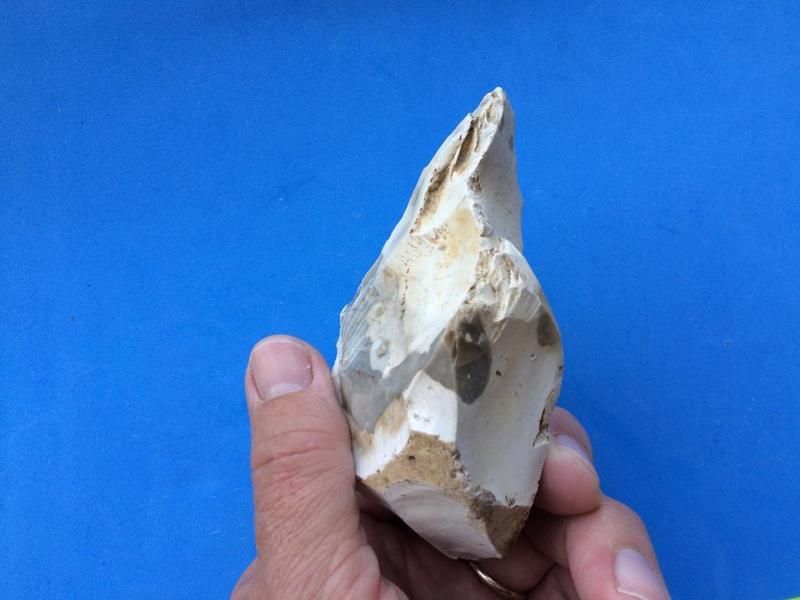
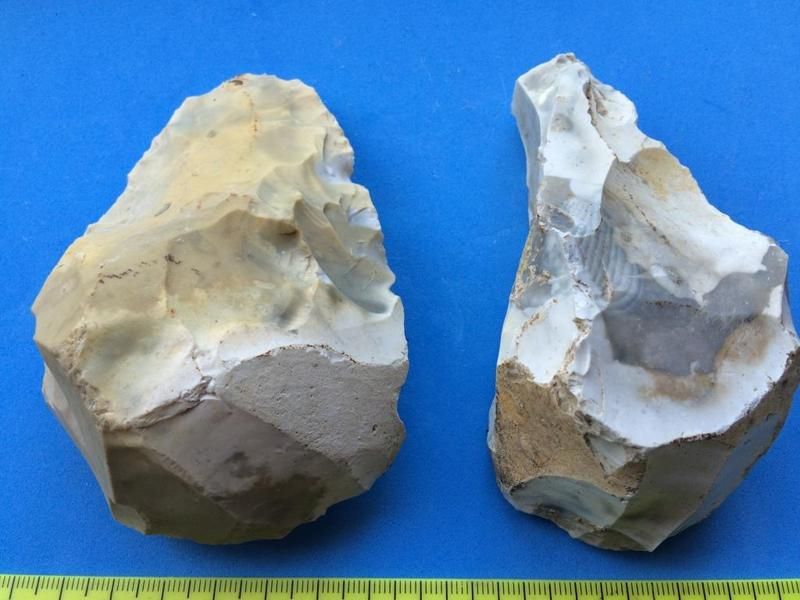
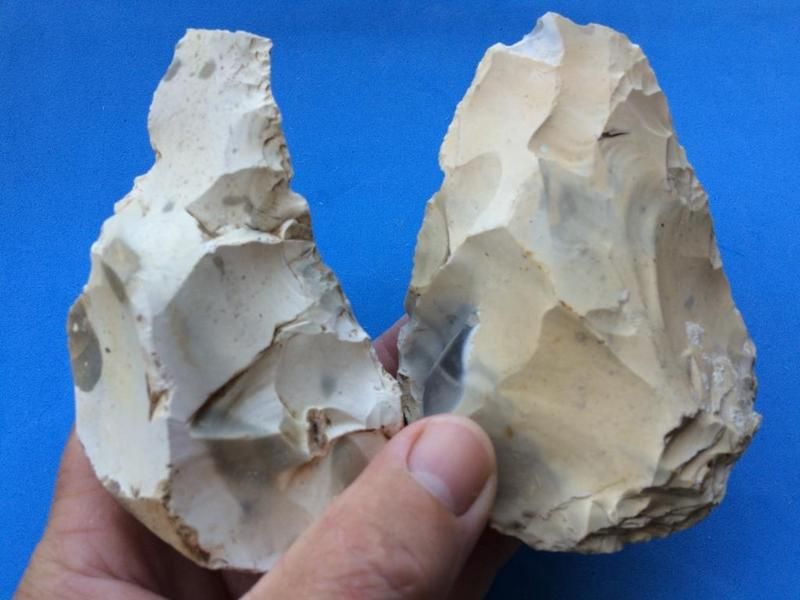
>>>>>>>>>>>>>>>>>>>>>>>>>>>>>>>>>>>>>>>>>>>>>>>> >> >>>>>>>>>>>>>>>>
Later in the day the next find of note was a broken axe of late Mesolithic/early Neolithic type. The axe has shattered due to a fossil inclusion within the blank. What I cannot determine is whether it broke during use or during production.
There is also some recortification on some of the facets on one side (the unbroken side); which I will try to capture in the photos. I also note that the recortification has only occurred on one side; which must reflect the position it lay and the presence of chalk slurry/solufluction, after being abandoned. It is also quite wide for an axe, at 9cm (total width).
It seems that aesthetics were not high on their list of features for axes of this period. They were functional first and pretty had to come second....this was no exception. But I am becoming accustomed to expanding my image of what was used as axes during that period. The profile is quite thick at the mid-section and thins out at the butt to form a pyramidal shaped point. I can only assume the antler socket must have been shaped to accommodate this, or else the break occurred before intended thinning had occurred ?
The break is not a frost fracture, which I have discounted as the fracture lines continue into the fresh flint of the core, from the break plane. There are also no other frost fracture lines on the blank, which one would expect on a frost weakened core.
1st picture, with the cutting edge on the left side; socket side to the right.
2nd picture shows the shattered section, with the remains of the cutting edge on the right of the photo. The edge itself seems to have survived the damage intact. So it doesn't appear that the damage radiated away from the cutting edge, but was shock induced.
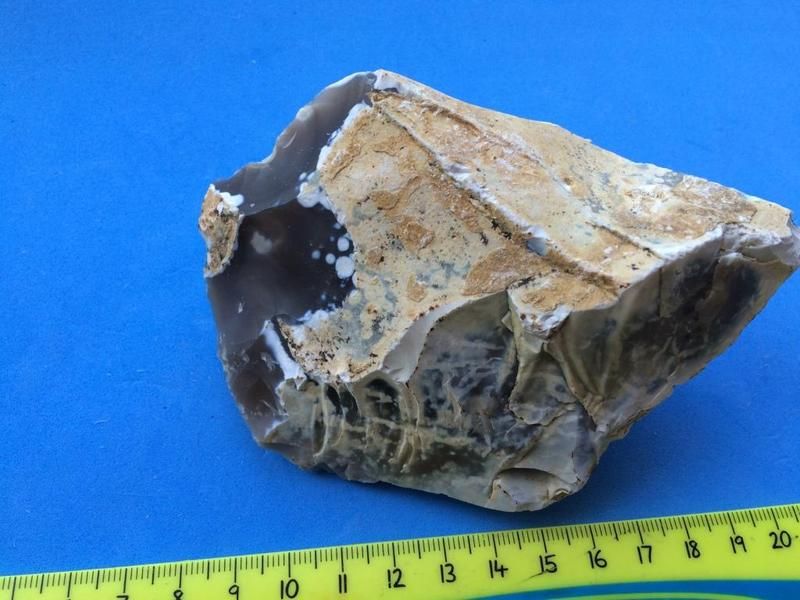
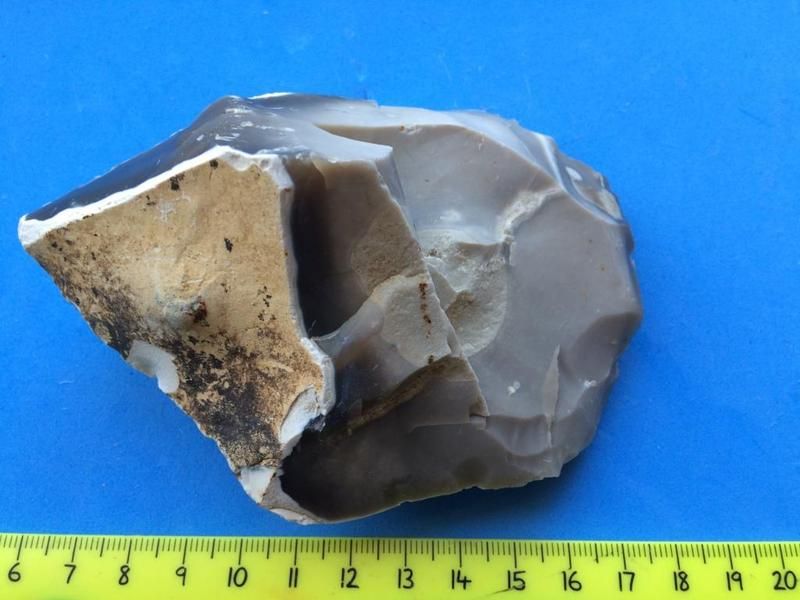
Undamaged face, showing recortification of some of the scars (not the one on the center of the cutting edge; which appears original). The zone to the upper right is just patination. The cortification area is to the left and center, from the end of dark grey/black to the ridges (top left)
There are a number of hairline cracks radiating from the fossil. On balance I would have thought the force to cause the fracture and number of hairline cracks are consistent with a higher degree of force being applied to the axe than would be expected during ‘thinning’. My guess is therefore that it failed during use.
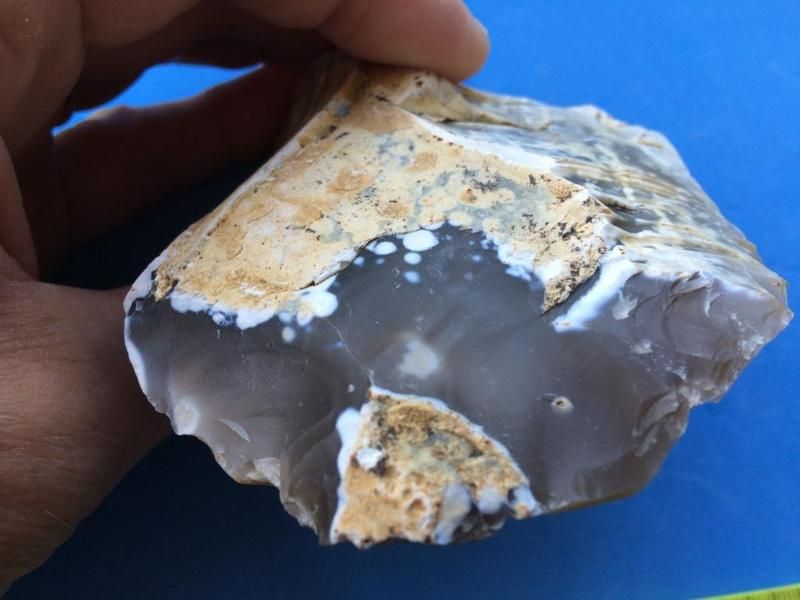
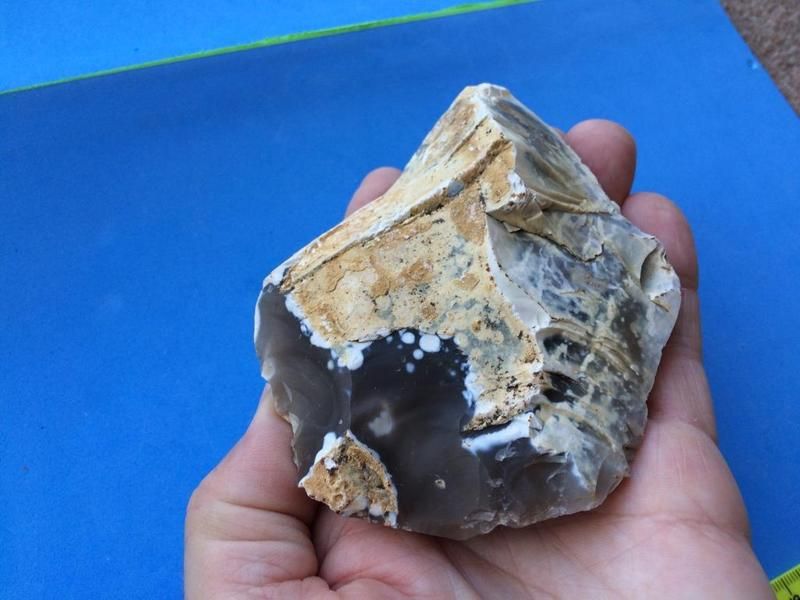
>>>>>>>>>>>>>>>>>>>>>>>>>>>>>>>>>>>>>>>>>>>>>>>> >> >>>>>>>>>>>>>>
So two axes and both broken. It was a great day to be out and I feel lucky to have found anything during a time of the year when there is limited access to ploughed/crop harvested fields.
First substantive find-of-the-day a broken handaxe. Any handaxe finds are truly incredible. I keep reading about how rich southern England is in Palaeolithic handaxes; but believe me when I say that the hours you have to put in to get one do not fit with the term ‘rich’ when it comes to actual numbers. Surface finds are extremely rare indeed. Gravel quarries have in the past been the richest sources of these objects, such as Dunbridge (now closed) and the many other quarries that have surrounded Romsey. The only one left working is very low to void of any lithics (apparently). In any event access to gravel sorting mounds is now the reserve of the archaeologists; who have persuaded the quarry owners that private collectors should be excluded.
So field finds and coastal erosion sites are the only sources left. Coastal erosion is slow here and well searched by a host of collectors. This leaves fields and trying to find the rare spots where older material can be found….you get the picture !
So there it was, sat in my hand, broken, but still a proper handaxe. Happy days. When washed it revealed the patination of the break to be contemporary with the fabricated surface. So the handaxe was either a failure during manufacture or failed during use. The most likely being fabrication, or resharpening, as the cutting of meat was hardly likely to cause a catastrophic failure.
The only mystery is the curious chipping along one of the broken edges. If the axe were complete then the scars would run long and deep into the blank. Along one broken edge there are ‘chatter’ marks that are not caused by water rolling; the edges are all fresh. This appears to be contemporary with the break, performed after the large slice had detached; as they are too far into the blank and would not have been consistent with the original handaxe. The retouch (if that is what it is) goes down the whole edge of the curved break; leaving it almost saw-like. This tends to suggest the broken axe was sharpened/retouched and thus used. This is supported by the fact that none of the other edge (opposite side of the break) has no retouch.
I also note the right angled flakes on the butt section, which has left three scars and some cortex. This method of fabrication (of thick-butted handaxes) is consistent for this area and I have pictured it next another similar axe to illustrate the point.



>>>>>>>>>>>>>>>>>>>>>>>>>>>>>>>>>>>>>>>>>>>>>>>> >> >>>>>>>>>>>>>>>>
Later in the day the next find of note was a broken axe of late Mesolithic/early Neolithic type. The axe has shattered due to a fossil inclusion within the blank. What I cannot determine is whether it broke during use or during production.
There is also some recortification on some of the facets on one side (the unbroken side); which I will try to capture in the photos. I also note that the recortification has only occurred on one side; which must reflect the position it lay and the presence of chalk slurry/solufluction, after being abandoned. It is also quite wide for an axe, at 9cm (total width).
It seems that aesthetics were not high on their list of features for axes of this period. They were functional first and pretty had to come second....this was no exception. But I am becoming accustomed to expanding my image of what was used as axes during that period. The profile is quite thick at the mid-section and thins out at the butt to form a pyramidal shaped point. I can only assume the antler socket must have been shaped to accommodate this, or else the break occurred before intended thinning had occurred ?
The break is not a frost fracture, which I have discounted as the fracture lines continue into the fresh flint of the core, from the break plane. There are also no other frost fracture lines on the blank, which one would expect on a frost weakened core.
1st picture, with the cutting edge on the left side; socket side to the right.
2nd picture shows the shattered section, with the remains of the cutting edge on the right of the photo. The edge itself seems to have survived the damage intact. So it doesn't appear that the damage radiated away from the cutting edge, but was shock induced.


Undamaged face, showing recortification of some of the scars (not the one on the center of the cutting edge; which appears original). The zone to the upper right is just patination. The cortification area is to the left and center, from the end of dark grey/black to the ridges (top left)
There are a number of hairline cracks radiating from the fossil. On balance I would have thought the force to cause the fracture and number of hairline cracks are consistent with a higher degree of force being applied to the axe than would be expected during ‘thinning’. My guess is therefore that it failed during use.


>>>>>>>>>>>>>>>>>>>>>>>>>>>>>>>>>>>>>>>>>>>>>>>> >> >>>>>>>>>>>>>>
So two axes and both broken. It was a great day to be out and I feel lucky to have found anything during a time of the year when there is limited access to ploughed/crop harvested fields.
Comment